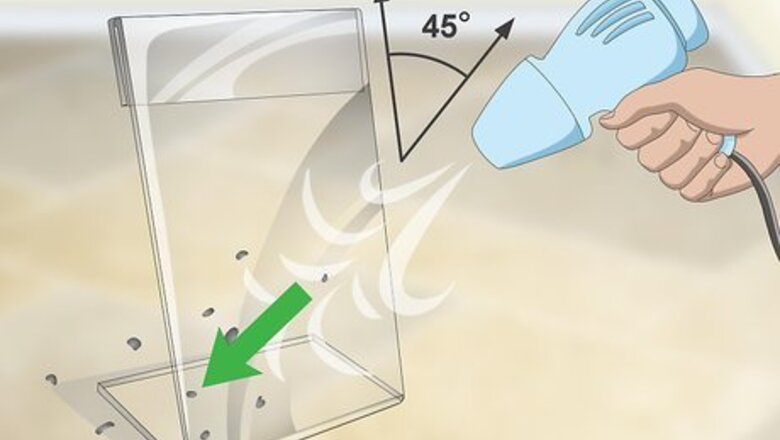
views
Removing Dust Particles
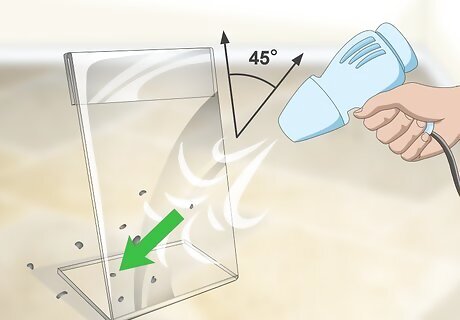
Blow dust and dirt off the plexiglass. Using your own breath or a hair dryer, blow the dust and dirt off the plexiglass. If using a hair dryer, be sure it is set to its coolest setting. Hot air will damage the plexiglass. Position the hair dryer at a 45 degree angle several inches away from the plexiglass, running the air side-to-side down the surface. Take the time to thoroughly remove the dust by air before moving on, and keep blowing if you see or feel any large particles on the plexiglass. Avoid using a microfiber cloth, because although microfiber is non abrasive, scrubbing dirt or dust with the cloth before blowing larger particles off will still scratch the glass. EXPERT TIP Claudia & Angelo Zimmermann Claudia & Angelo Zimmermann House Cleaning Professionals Claudia and Angelo Zimmermann are the founders of Everneat, an Eco-Friendly Cleaning Service based in New York City and in Connecticut. They are also the founders of Clean Code, a DIY 100% natural cleaning product line. Claudia & Angelo Zimmermann Claudia & Angelo Zimmermann House Cleaning Professionals Try using a microfiber duster to remove dust and dirt. Plexiglass is delicate and very easy to scratch, so it's important to remove any particles from the surface before you clean it. Try wiping it down with a dry suede microfiber cloth to dust the surface very gently. You can even try glass cloths since they're woven compactly so particles don't get easily trapped between the fibers.
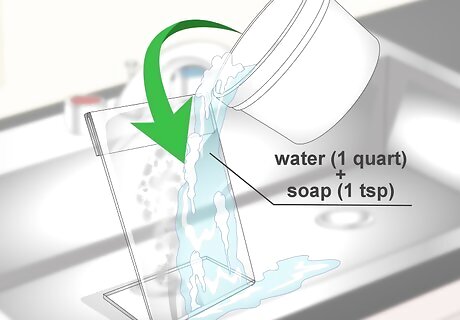
Wet the plexiglass with a solution made from water and dish soap. Mix 1 teaspoon (5 ml) of soap into 1 US-quart (950 ml) of water. Angle the plexiglass at 45 degrees and gently pour the solution over the plexiglass. Be sure to do this in a sink or someplace that will not be damaged by running water. You can also pour the solution into a spray bottle, and gently spray the plexiglass. Keep the plexiglass at a 45 degree angle and allow the mixture to run down the plexiglass slowly. Gently running this mixture over the plexiglass will remove the smaller particles of dust and dirt, preparing the glass for wiping.
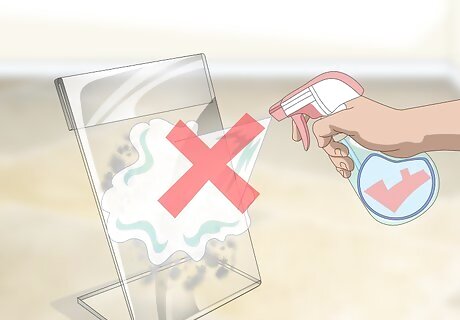
Avoid using products with alcohol, ammonia, or aromatics. Products like Windex, which contain alcohol, will significantly damage plexiglass. Also avoid solvents such as acetone, dry-cleaning fluid, or any gritty cleanser or polish, as they will damage the surface of the plexiglass. Although it is best to use a soap and water mixture, there are some products you can buy that are meant specifically for plexiglass, like Brillianize or Novus.
Wiping the Surface
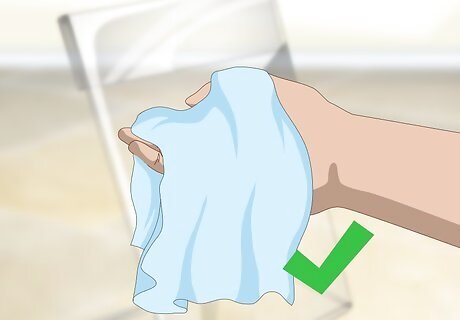
Use a microfiber cloth to prevent surface scratches. Because plexiglass retains dirt and grime, using something like a paper towel or tablecloth will scratch the surface of the plexiglass. Microfiber cloths will not dig into the pores of the plexiglass and will not damage or scratch the plexiglass once the dirt has been blown off the surface. Good alternatives to microfiber cloth are cheesecloth, terry cloth, jersey cloth, cotton flannel, or any other non abrasive material.
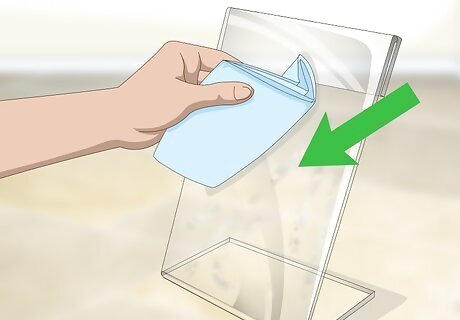
Wipe the wet plexiglass with your microfiber cloth. Carefully wipe along the plexiglass surface being sure to only touch portions of the plexiglass that are still wet from the solution. Focus on particularly dirty spots, taking special care not to scrub or apply too much pressure to the surface.
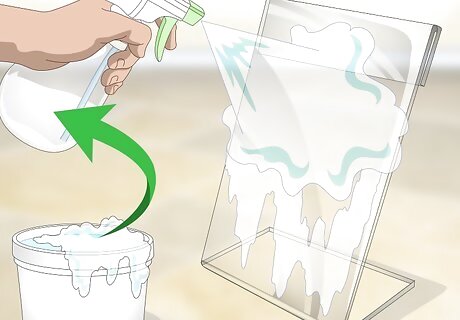
Spray the solution onto the surface and gently wipe any grime that still exists. If you have wiped the surface of the plexiglass once and the plexiglass is still dirty, pour the solution over the plexiglass again and repeat the process of gently wiping with a microfiber cloth. Repeat this process as many times as necessary.
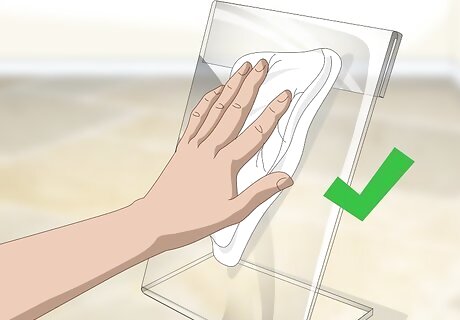
Wipe the plexiglass until it is dry. Do not allow the plexiglass to air dry or sit for too long while it is wet, or else you will leave behind visible water spots. If you find that your plexiglass has dried and retained water spots, just repeat the cleaning process again. Water spots are not anymore difficult to remove than dirt or grime, and should come off easily.
Repairing Scratched or Especially Dirty Plexiglass
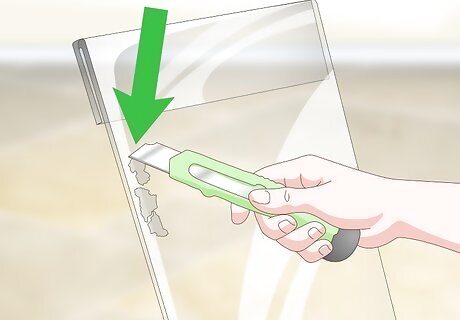
Scrape grime or dirt off with a razor blade. Using a razor blade or any other sharp scraping tool, carefully and evenly run the blade from side to side, removing the grime. Angle the blade to ten degrees, or at an angle that will not press into the plexiglass in a damaging way. If there are any markings that you would like to remove from the plexiglass, using a razor blade will take care of the problem. Using a sharp tool like a razor blade is great for shaping any jagged or uneven edges. Slowly slide over the edges with the razor blade, shaving small pieces off evenly until the uneven edge suits your needs. Be very careful with sharp scraping tools, as they could cause injury if used incorrectly.
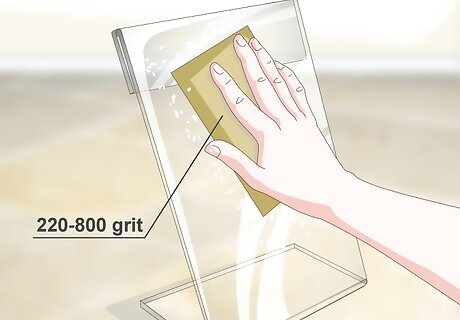
Sand the plexiglass to remove deep scratches or markings. Sand the acrylic just like you would with a piece of wood, by hand or with a sander. Work your way across the surface with a more coarse sandpaper and moving on to a finer sandpaper. Do not press the sander onto the plexiglass with any force; be gentle and keep the sander moving at all times. This will decrease heat buildup, which damages plexiglass. For deep scratches, begin with a 220 grit or 320 grit piece of sandpaper and move up to a 600 grit or 800 grit sandpaper later on. Always wear a mask when sanding to avoid dust inhalation.
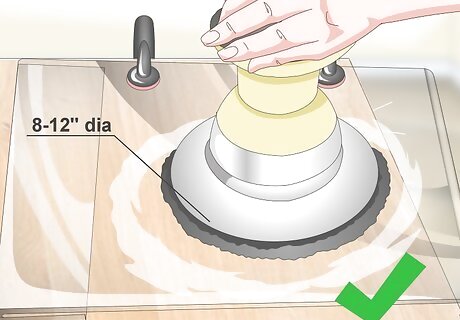
Buff the plexiglass after sanding it. Use a stationary polishing wheel (or a dremel tool with a buffing pad) to bring the plexiglass back to a nice, clear finish. In order to avoid applying heat to the plexiglass, use an 8 to 14 inch (20 to 35 centimeter) diameter piece of bleached muslin with bias strips, which keeps the wheel from getting too hot. Clamp the plexiglass in place so that it doesn’t move while buffing. Use a medium cutting compound for a glossy finish or a fast cutting compound for a higher luster finish.




















Comments
0 comment